

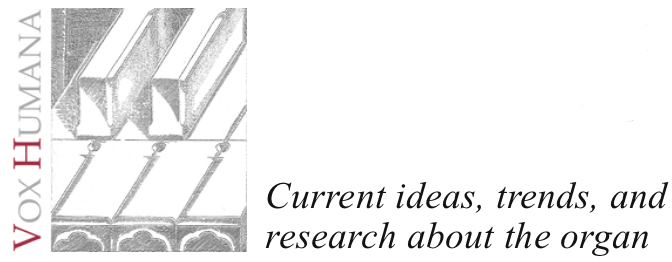
May 6, 2018
CICELY WINTER
–––––––––––––––––––––––––––
Historic Organs in Oaxaca, Mexico

May 6, 2018
CICELY WINTER
–––––––––––––––––––––––––––
Historic Organs in Oaxaca, Mexico

The 1686 organ (builder unknown) at the Basílica de la Soledad in Oaxaca, Mexico.
The 1686 organ (builder unknown) at the Basílica de la Soledad in Oaxaca, Mexico.
Introduction
Cicely Winter, organist and musical anthropologist, discusses cataloguing, preserving, and coordinating restorations of seventeenth through nineteenth century organs built by indigenous peoples in Oaxaca, Mexico with Vox Humana Editor Christopher Holman.
––––––––––––––––––––––––
Cicely, many thanks for agreeing to this interview. You are one of Mexico's leading musical anthropologists, and for the past 17 and a half years, you have been active cataloguing and preserving historic organs in the state of Oaxaca [pronounced "waːˈhɑː.kɑ"], Mexico as Director and co-founder of the Instituto de Órganos Históricos de Oaxaca (IOHIO). What is IOHIO [pronounced "yo-yo"], and how did it begin?
The Instituto de Órganos Históricos de Oaxaca or Institute of Oaxacan Historic Organs is a Mexican non-profit organization dedicated to the protection, conservation, documentation, and promotion of the 72 historic pipe organs registered to date in the state of Oaxaca. It was founded in 2000 as a result of the combined talents and interests of three people: Edward Pepe, organist and co-founder of the Westfield Center with experience in organizing organ initiatives in the United States, Alfredo Harp Helú, philanthropist and financier of organ restorations, and myself, keyboard player and Oaxaca resident since 1972 with organizational experience at the local level. The IOHIO is a unique and multi-faceted project which started by pure serendipity and after eighteen years, is an internationally known and respected organization.
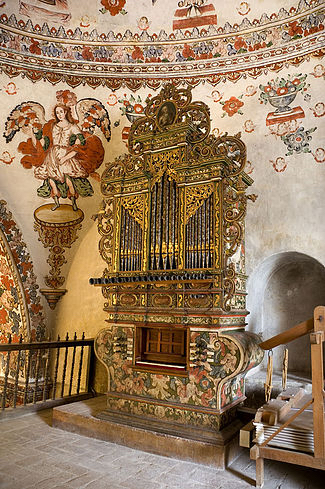
I met Edward Pepe (who was spending his winters in Oaxaca) soon after I had returned from studying a graduate level program in piano (and a bit of harpsichord) at Indiana University. At that point, playing the organ never occurred to me, and I was hoping to develop a career as a pianist. But a major earthquake in 1999 closed the downtown theater where the only decent piano in town was located, and the director decided to embark on a remodeling project which went on for several years. I accompanied Ed to Tlacochahuaya to hear him play the organ and was fascinated. I did have some knowledge of baroque music from my harpsichord studies with Lory Wallfisch at Smith College. But it was during a semester of study with Elisabeth Wright at Indiana University that I was introduced to the completely unknown world of seventeenth century keyboard music (Frescobaldi, Froberger, Couperin, and beyond) — I loved this music and was eager to try it out on the organ, but I found the organs in Oaxaca rather intimidating; the short octave, the divided registers, the low pitch and the meantone temperament completely threw me. Equally unnerving was the “ideal” repertoire of sixteenth and seventeenth century Iberian composers. The tientos of Correa de Arauxo were as incomprehensible to me as a foreign language!

A few more practice sessions in Tlacochahuaya convinced us to put together a concert, and Ed, another organist friend, Tom Smith, and I presented our first concert on February 5, 2000, the first clue for the Oaxacan public of what was to come. The church was packed with close to 600 people, filling the benches and sitting on the floor all the way up to the altar. Clearly people knew that the organ had been “fixed”, but few had heard it played since its inaugural concert in 1994. Don Alfredo Harp Helú and his wife Doctora María Isabel Grañen Porrúa attended the concert and were stunned by the turnout. Alfredo had already demonstrated a particular interest in historic pipe organs by financing four restorations in Oaxaca through Banamex (Banco Nacional de Mexico) which he co-owned. So in response to the success of our first concerts, he offered to support a new organization dedicated to the conservation and promotion of the Oaxacan organs and to provide us with office space in the recently remodeled Philatelic Museum of Oaxaca (MUFI). In August 2000, the IOHIO was officially registered as a non-profit organization (Asociación Civil or A.C.).
We set to work immediately and played concerts on the restored organs, particularly those restored in the late 1990s by Susan Tattershall, in Tlacochahuaya, the Oaxaca Cathedral, and Zautla. We visited the towns where unrestored organs had been reported, established contacts with the authorities, and started to define a conservation plan involving cleaning, photographing, and measuring the organs. And of course we were dying to discover more organs. At that point, 45 had been registered and over time we were able to add 27 more to the roster to reach our present total of 72. We’re certain that there are more out there, but finding them before they disappear is an ongoing challenge.
In early 2004, Edward decided to leave the IOHIO in order to focus on independent research in Mexico City. Everything I knew about organs I had learned from him, but I still had a long way to go. Fortunately, Susan Tattershall, who had restored three Oaxacan organs in the 1990s, accompanied our collaborator-architect José Luis Acevedo and me on field trips and helped us understand the technical aspects of organ construction. The IOHIO continued its mission until June 2017, when after 17 and a half years with the Fundación Alfredo Harp Helú Oaxaca (FAHHO), the foundation decided to phase it out as part of a general downsizing initiative. The separation was amicable and I will always be grateful beyond words to Don Alfredo for his support, which ended up changing my life profoundly. Now our financing depends entirely on private donations and happily the response to our recent fundraising campaign has been extremely generous (sincere thanks to those of you who have contributed). We operate on a shoestring budget, and a little here goes a long way. The IOHIO no longer has an office in the Philatelic Museum, but my half-time assistant Joel Vásquez and I work from home or in the churches, and this has not been a problem. Donations will cover our operating expenses and special projects for most of the year ahead, and we feel energized and optimistic about the future.
When you began cataloguing the organs, how did you find them, and where did you begin?
First we concentrated on visiting and registering the 45 known organs. As the word spread about our project, we were contacted by people from the villages who thought they might have an organ, by priests, by friends with contacts in the villages, or messages through the Instituto Nacional de Antropología e Historia (INAH). We found a few just by exploring the area around our organ towns. And in one case it was a hunch based on studying a map of the Mixteca Alta. Most so-called “organs” have turned out to be harmoniums, although the authorities in one village had every reason to be hopeful since their harmonium was set within an imposing tall case filled with a rank of silver painted wooden pipes across the façade! Now if we get a tip about an organ, we ask them to just take a picture and send it to us, when before we had to travel to see it. Even though all recently reported “organs” have turned out to be harmoniums, we’re still hopeful.
The Dominican churches of the sixteenth through eighteenth centuries are the most important leads, since they would have had or still might have an organ. We know which of the main churches has lost their organ, but we need to visit the smaller churches, many of which are located in recently depopulated villages in the Mixteca Alta. I continue to be amazed by the national organ survey Guy Bovet directed in the 1980s when so many communities lacked a decent road or even a community telephone to set up an appointment. We have spent many hours over the years waiting for the person with the key to the church, who may have left on an errand or forgotten about our appointment and gone off to his field for the day, but I´m sure it’s nothing compared to what Bovet and his team had to deal with.
The most important aspect of our field work is protection of the organs, and over the years we have developed an effective strategy to help raise consciousness in the villages. Our visits always begin with a meeting with the local authorities in the municipal office. We distribute brochures to everyone present, donate a CD of Oaxacan folk music recorded on the organ, talk to them about the organ in their church, refer to our previous visits (and do a little name dropping of the authorities who attended us then, usually friends or relatives of the present group), describe the goals of the IOHIO and specify the work we intend to carry out that day (cleaning, measuring, and photographing) and ensure they understand that it will cost them nothing. One of them is responsible for opening the door to the church and the choir loft and keeping an eye on us, but usually more will come along because it’s something new and different. During our first visits, nearly all the authorities admitted that it was the first time they had ever seen the organ up close, or even been in the choir loft — they were also impressed to have a view of their church from above.
We realized that just talking to people wasn’t enough, and when the authorities changed, passing on information about the organ had never been a priority. So we started leaving information sheets resting on the cases of the organs. In fact, most people had no idea that the piece of furniture in the choir loft, often referred to as an armoire (ropero), used to be an organ (and then we need to tell them what an organ is and why it was there). These sheets are backed by cardboard and protected with a plastic sleeve. One states that the organ is part of the national cultural heritage and protected by federal law through the INAH (this indicates that you can’t just dismember it for parts or burn it up), and a second sheet includes the IOHIO logo, historical information about the organ, a list of “dos and don’ts” to guide the community, and the dates of our previous visits to that organ. Since we started leaving these guidelines, we haven’t lost a single one.
Soon after the project started, we heard of two that had recently been destroyed, one of them a 4´ table organ still played in the 1950s in a remote area of the state. We knew the organist, now elderly, and hoped to visit the village with him, but he was able to ascertain through contacts that the organ “isn’t there anymore.” Another organ was in a village deep in the Sierra Juárez mountains and may have been destroyed by order of the priest. The bellows from a 1776 organ were about to be thrown into a bonfire of useless church junk when someone thought they seemed sort of unusual and rescued them. By the way, a wonderful organ in a remote village might serve very well in a church in Oaxaca City which no longer has an organ. But by federal law, an organ may not be moved from its place of origins.
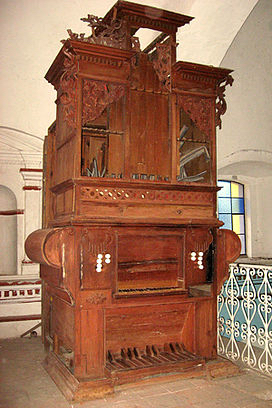
But apart from these, the other unrestored organs are in varying stages of repair. About ten are nearly intact, whereas five or six are represented by only a few pieces (based on which we can reconstruct the organ in our minds). In most cases the façade trumpets, so easy to remove, have been dislodged, tooted on for fun, and discarded, and most of our intact cases display a row or rows of empty holes across the facade where the pipes were once placed. The small interior pipes are also easy to pull out and blow, so they’re the next to go. Many organs have no pipes left at all. They were a convenient source of metal to melt down for bullets during the revolution, but also very useful for the local metal smith. If the keyboard cover is missing, some if not all of the keys will usually disappear. We heard of an instance where the keys were used for mixing paint during a church repair. Carved decorative pieces may easily vanish as curiosities, as well as doors and planks on the sides and back of the organ. They may have been random acts of vandalism by individuals or a result of a directive from the priest or a town authority, usually as part of a clean-up and modernization of the church. The organ may have been removed from the church if the roof was changed, a new choir loft built, or the loft repaired after an earthquake, and our first priority is always to move the organ back into the church. Our festival tours also call attention in the communities to the importance of the organ, since so many people come from far away to see them.

What are the typical characteristics of Oaxacan organs? How did they evolve over time, and how do they differ from instruments in Spain?
Oaxacan organs and their churches tend to be relatively small, reflecting the size of their communities. The state’s geography is largely mountainous; villages are dispersed and until recently were isolated with their own languages, native costumes, and traditions (which nowadays are unfortunately disappearing). Earthquakes are an ongoing peril, and construction in general is low and broad-based. Repair and rebuilding activity has always been a fact of life. The majority of our organ towns are located in the Mixtec area to the north of the state and oriented toward Puebla and Mexico City and the Zapotec Central Valleys where Oaxaca City is located.
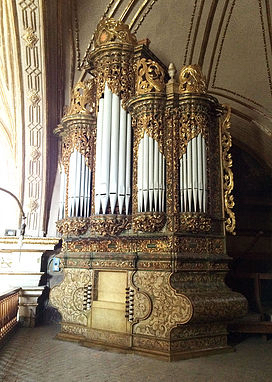
Our knowledge of the Oaxacan School of organbuilding is based on the remaining organs which span two centuries, from the oldest in the Basílica de la Soledad (1686) to the most recent in Santa Cruz Amilpas (1884). Some organs in the northern part of the state were built in Puebla in the second half of the nineteenth century, but they’re stylistically different. Our instruments have only one manual and no pedals, and were based on Renaissance Spanish models. In Spain the organs continued to evolve, whereas in Oaxaca they became frozen in time. They include 2’ table organs, 4’ table and stationary organs, and 8’ stationary organs. No organs have 16’ stops, and even the most monumental, including the Basílica de la Soledad, Oaxaca Cathedral, Yanhuitlán, are 8’ organs. They were positioned sideways in the choir loft so that the organist could see and coordinate with the priest and not have his back to the altar.

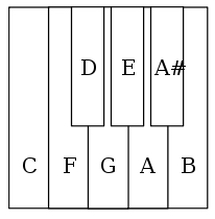
The early organs were consistently tuned in meantone temperament with a short octave and a 45-note keyboard C – c''' (the left hand has 21 notes, the right 24). The pitch varied between A = 392 and 415 Hz. By around 1840, the short octave was eliminated, adding four notes to the bass, and extra notes were gradually added to the treble, ultimately reaching 56 notes (C – g'''). Innovations in organbuilding came from Puebla to the north, although they probably originated in Mexico City. Around this time, we also begin to see a general trend toward equal temperament, but the pitch level still varied. The Jalatlaco organ, built in 1866 and restored in 2016 was set in “almost equal temperament”, and pitched at A=396 Hz. This is surprising, because by then, pianos pitched at A= 440 were already beginning to arrive in Oaxaca. In the twentieth century, pipes of several organs were cut to raise the pitch to 440 (as seen in Tlacolula), or the lowest bass pipes were cut to replace the short octave with a chromatic arrangement (as in Zautla).

All Oaxacan organs without exception have registers divided at middle c/c-sharp (“registros partidos”). The treble and bass stop knobs are set in rows on either side of the keyboard, or in table organs, slider tabs on either side of the case. These correspond to the lower (C – c') and upper (c#' – c''' or c# - g''') halves of the keyboard. By the nineteenth century, the registers are nearly continuous for both halves and in a more or less standardized progression. Table organs had sticker action with the chest located under the keyboard, whereas stationary organs had direct suspended tracker action or rollerboards.
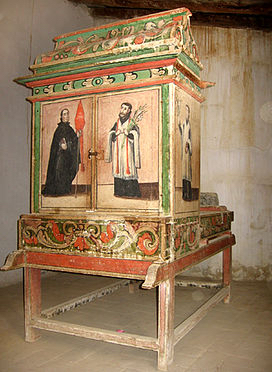
Seven table organs have a 2' principal (“flautado”) and these all have a 4' stopped or flute register to provide a workable tonal base. Six of them were built ca. 1720–1730 and are almost identical in their construction. Although they were modeled on sixteenth century Spanish table organs, not one exists in Spain today. They are located in choir lofts or balconies and not movable, so were not used in processions (as their ancestors had done during the early days of Dominican evangelization). These charming little organs are profusely decorated with painted flowers and images of saints, archangels and/or angel musicians. The upper registers break back (repeated rather than sequential octaves) to avoid the highest pitches in the treble or to reinforce the bass, and the stops are not mirrored. They all have two accessory (toy) stops — a drum and a nightingale (“pajaritos”). The pipes are arranged chromatically on the chest. Their size corresponds to their small churches, or else they may have served as a second organ in a larger church. The last organ of this type is from 1730.

4' table organs were only built until around 1800, whereas 4’ stationary organs continued to be built throughout the nineteenth century. Table organs usually had the toy stops, whereas stationary organs did not. The pipes of the stationary 4’ and 8’ organs are set in different arrangements on the chest: diatonically, or in chromatic or pyramid layout according to the divisions of the façade. In the eighteenth century they too are often lavishly decorated, carved and gilded (Tlacochahuaya, Zautla, Soledad, Yanhuitlán come to mind). The façade pipes are often decorated with faces (“mascarones”), a feature common in other Mexican and European organs. But the pipes of Oaxacan organs are decorated with flowers in their entire length, a feature not seen on other Mexican organs. By the nineteenth century, the cooler neo-classic aesthetic predominated with its distinctive carved decorative motifs, but by then organs were either unpainted or painted and discreetly decorated in one or two colors.
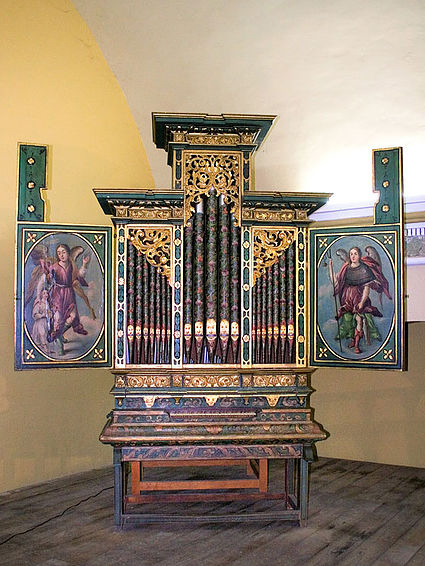 The 1726 organ (builder unknown) at San Andrés in Zautla, Mexico, with pipes painted with faces and flowers. |
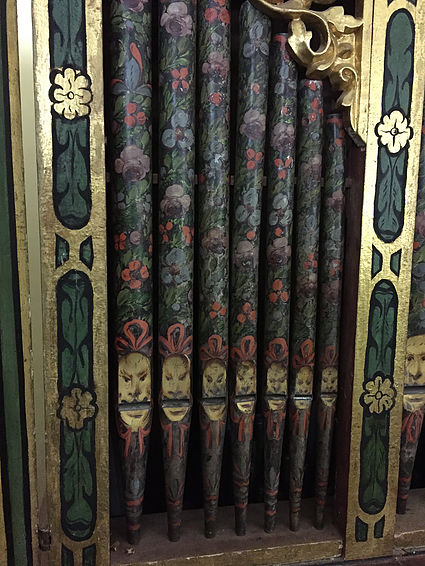 Detail of the painted façade pipes on the Zautla organ. |


The bellows were in wedge form, usually with ribs but not always. Around the mid-nineteenth century, they were displaced by reservoir bellows.
The case design of Oaxacan stationary organs is idiosyncratic; instead of straight sides, they have what we refer to as “hips”, rounded lateral protuberances. These are consistently present throughout the two centuries of Oaxacan organbuilding, although they vary in size and profile. Their function remains a mystery; perhaps they provided ballast or extra width during earthquakes, or perhaps they were merely decorative. But for whatever reason, the Oaxacan organ hips were an ingrained stylistic feature by at least the late seventeenth century, and may have had much earlier roots.
Who built these organs? From where did the materials come? What do modern Oaxacans think about them?
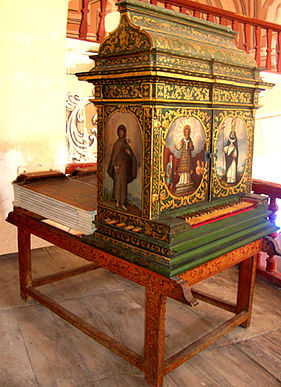
When the first galleons arrived in New Spain full of tools, seeds, animals, etc., table organs were also included in the cargo, since the missionaries knew that music could advance the evangelizing process. Instrument building shops were functioning within a generation after the Conquest in Mexico City. The earliest reference to a Oaxacan organ is from the Cathedral in 1545 (there are extensive archive records of the Cathedral organs, which were replaced several times, each time with a larger instrument as the congregation grew). The Codex Sierra from 1558 describes, with pictographs and Spanish and Nahuatl text, the purchase of a box of organ pipes from Mexico City for the community of Sta. Catarina Texupan in the Mixteca Alta. The pipes are the most complicated aspect of organ construction and it’s no surprise that they weren’t being made in Oaxaca right away, but we might guess that the wooden components of the Texupan organ were built in Oaxaca. This may have been the case with the first Cathedral organ as well. The pre-Hispanic Mixtec and Zapotec civilizations were highly developed and boasted a rich artistic tradition, and the Spaniards would certainly have drawn upon local talent. Another early document from 1603 cites the transport of an organ that was carried all the way from Mexico City to Tamazulapan by five men (around 340 miles/550km).

Paper labels in the interior of the case give us additional information; they may or may not name the organbuilder in the eighteenth century. In one of the 2´ table organs in the Mixteca (1730), the label notes the date, cost, and names of the authorities, but does not mention the name of the builder. Yet in another almost identical organ from 1724, the organbuilder is named. By the nineteenth century, a few more signatures appear inside the cases, but it’s not consistent, and the most complete information is still found in the contracts. By then, the organbuilders were invariably Oaxacan.
Organs were made out of local wood, most commonly of pine; but some varieties of pine withstand woodworm better than others. We’ve seen some organs where the lower case has been chewed to pieces, but gradually improves as you go up to the carved top of the upper case, which is still lovely. Organ cases built of cedar, impervious to woodworm, are in excellent condition. The chest and its components were almost always built of cedar, even if the rest of the case was pine, because the builders knew that the chest had to survive. The sharp keys were made from various hardwoods — cedar, ebony, orange wood, and some we haven´t been able to identify — and the naturals of pine or cedar with bone covers. The lead and tin for the pipes would have come from the mines to the north, but it’s likely that there were specialists in Mexico City or elsewhere who supplied the alloyed material to organbuilders around the country.
Invariably, people today in the villages want to know where their organ was made, and are amazed to hear that they were made in Oaxaca by Oaxacans. I don’t know how many times we have explained this, but the notion exists that anything important or impressive like organs was imported from Europe. We also stress the sacrifice of their great-great-great grandparents in financing the organ’s construction, which resonates in a culture which honors and respects ancestors.
We can tell from the height of the keyboard in relationship to the floor that organist had to stand to play the 2’ and 4’ table organs. Yet in other eighteenth century churches, the relationship between keyboard and floor level implies that the organist sat (we’ve even found a few of their chairs). In Tlacochahuaya the organ is raised on a cement platform, probably so that rain streaming through the window of the choir loft (which originally did not have glass), wouldn’t damage the organ. The keyboard heights in Zautla and Tamazulapan, our two restored table organs, indicated that the organist would have stood, particularly taking into account that Oaxacan people are small of stature and were probably even shorter in colonial times.
How were organs used in Oaxaca over the centuries? Who played them, and does any written repertoire survive?
Oaxacan organs were always located in churches and accompanied the liturgy. There is no evidence of a house or private chapel organ. We find archive references of payments made to the organist (and bellows pumper) for masses for Corpus Christi, an important celebration in past centuries, Christmas and other feast days.
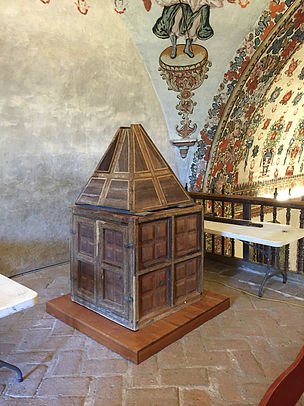
During the sixteenth century the priority was evangelization, and music was an important tool. Small table organs would have been carried in processions around the atriums of the open chapels to accompany the chant for mass baptisms and catechism. Large illuminated choir books and their wooden lecterns (“facistoles”) still exist in many Mexican cathedrals, so we know what was sung, but not what was played. One wonders whether the classical Spanish seventeenth century repertoire of Correa de Arauxo, Cabanilles, Bruna, etc. was actually played on Oaxacan organs, who played such music, or if the scores were easily available in the sixteenth and seventeenth centuries (we know that Correa’s scores, for instance, made it to Mexico, but not necessarily if they ever made it all the way to Oaxaca).

Organ music seems to have been improvised, or memorized and not written down, as none of the table organs has a music rack. We had to construct one (removable of course) for the Zautla organ because loose sheets resting against the façade pipes would be blown away by the air emitted from the pipe mouths. In Tamazulapan, our other restored table organ, we use a temporary rack, and anchor the pages with clothespins so they don´t blow away. All the 8’ organs were designed with racks, implying that scores could be set there.
By the eighteenth century we have a clue about the style of liturgical music from the works of the Mexican composer Manuel de Sumaya, who spent the last years of his life (1738–1755) as maestro de capilla in the Oaxaca Cathedral. The one source of written keyboard music from colonial times is the Cuaderno de tonos de maitines de Sor María Clara del Santísimo Sacramento (“Notebook of Psalm Tones for Matins of Sister María Clara of the Most Blessed Sacrament”). It contains a series of versets in the eight psalm tones which were compiled but not composed by Sor María Clara, an organist nun in the Conceptionist convent in Oaxaca, around 1830. It may be the earliest written organ music in Mexico. Her grandfather and uncle were both organists in the Oaxaca Cathedral, and one of them probably composed the verses around 1800. The compositions seem to be didactic, as they are set systemically in the series of psalm tones and are not technically difficult. Whenever possible we try to incorporate some of the verses, short, light, and in the gallant style, into our concerts. You may read more about the Martinez family dynasty of organists, organbuilders, and organist nuns, which was founded by the nun’s grandfather in the 1780s and lasted around 100 years in Calvert Johnson’s edition of the Cuaderno de tonos, available here.
Before the Second Vatican Council (1962–1965), the Mass was celebrated in Latin and sung antiphonally between the organist/cantor and the priest. Some elderly people in the villages still remember participating in choirs as children with Latin repertoire. Vatican II with all its positive reforms, unfortunately marked the death knell of the pipe organs in Oaxaca, because other local instruments were now allowed to accompany the Mass. This meant that churches were no longer required to pay to maintain the organs, previously the only legitimate liturgical instrument, nor pay for the organist and the bellows pumper. A few organs functioned in the 1970s, but after that they were left to deteriorate. We have been told about two organists who played the organs then; one was an elderly lady who played in the Jalatlaco church, and the other was a man from Sinaxtla who went around and played the organs in several nearby towns. They would have played the mass and known liturgical music for marriages or baptisms, but I suspect it wasn’t especially sophisticated.
You’ve catalogued the historic instruments in the region of Oaxaca, many of which are in remote places where the principal language is not Spanish, but dialects of Zapotec or Mixtec. How do you make contact with these places and establish and maintain good relationships?
As far as language and communication with the authorities, no matter how remote the village or how strong the preservation of the local language, the men at least will all speak Spanish. They will confer among themselves in their native language, but incorporate the word “organ.” The schools are generally bilingual with the goal of preserving the native language while teaching the children Spanish as well so they can navigate in the modern world. Teachers from the small communities are trained in Oaxaca City and then return to teach in both languages. Communication is much easier now than it used to be, because invariably there will be someone in the village with a cell phone, although then again there may not be reception except on top of a nearby hill. Before that, there would often only be one telephone in the entire village, and if a call should come in, that person was called over a megaphone to come to the phone booth. This is still the case in some villages where there is no cell or normal telephone signal and the community phone has a satellite signal. You leave your message, then call back in 10 minutes or so when the person may or may not have shown up to take the call.
In addition to this invaluable field research, the IOHIO has also restored several historic organs. How do you prioritize which instruments undergo restorations? Who has been involved with this work, and how have the communities responded?
There are ten functioning organs in the state of Oaxaca, restored, reconstructed, or in one case, simply repaired, and IOHIO has organized and received funding for two of those. Six were finished before we started and had been restored to great acclaim, but the follow-up plan to have them played and maintained regularly was inconsistent. However, the word “restoration” in the context of early Mexican organs has some sort of mystique, and very early on we had a reputation for having done all those restorations, when in fact we hadn´t done any! For many years our goal was to consolidate the work that had already been done by Susan Tattershall (Cathedral, Zautla, Tamazulapan) and the Academia Mexicana de Música para Órgano Antiguo (AMMAO) based in Mexico City (Yanhuitlán and Soledad, later followed by Tlaxiaco) — i.e. make use the organs that were already restored, rather than advance with new projects.
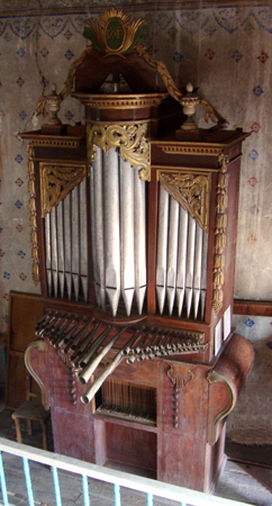
Alfredo Harp Helú suggested in 2007 that the IOHIO restore some organs, and who could ever turn down such an opportunity? But we took our time in formulating a plan. The logical candidates were the 10 or so relatively complete organs. The list was quickly narrowed to four, because six of them were located in remote areas with little guarantee of ongoing use. The criteria we consider are: the historical value of the organ and its condition; the interest in the community and the support of the priest in having a functioning organ; the likelihood that the organ will be played regularly in the future; and the location near Oaxaca City or another important population center. An example of an organ that’s restorable but doesn’t make sense practically is in Santa María Tinú. The organ (1828) is intact and will still make noise if you pump the bellows, but unfortunately there are only 150 people left in the town and you have to cross a river to get there.

When we felt ready to put this plan into motion, we invited Gerhard Grenzing (El Papiol, Spain) to take a look at the possibilities in Oaxaca at the same time that his company was restoring the second of the two monumental organs in the Mexico City Cathedral. The winners were obvious: the organs in Santa María Tlacolula and San Matías Jalatlaco which were restored in 2012–2014 and 2016 respectively.
It was a pleasure to work with the experts from the Grenzing shop on both restorations. The rest was not so easy and I had to be the liaison between all entities; the FAHHO, the communities of Tlacolula and Jalatlaco (which provided food and lodging to the organbuilders, a prerequisite for funding by the FAHHO), the INAH in Mexico City (which periodically sent its representatives to Oaxaca to check on our work), the Grenzing company in Spain, and Mexican customs for the Jalatlaco restoration (importation of tools, materials and new pipes from Spain… a nightmare!).
As far as the restoration themselves, the main challenges in Tlacolula were to extend the pipes to lower the pitch from 440 to 415, make some new pipes, restore the chest, and releather the bellows. In Jalatlaco the pitch was intact, but about 30% of the pipes were rebuilt (including the entire clarín). There was extensive woodworm damage, and the chest and bellows had to be nearly rebuilt.
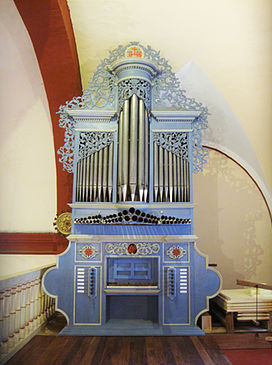
The c. 1866 Pedro Nibra de Oaxaca organ at San Matias in Jalatlaco, Mexico.
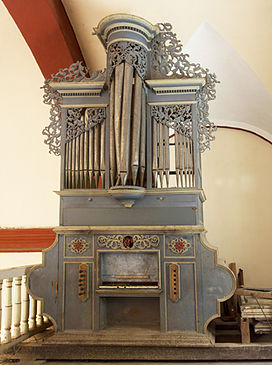
The same, but before restoration.
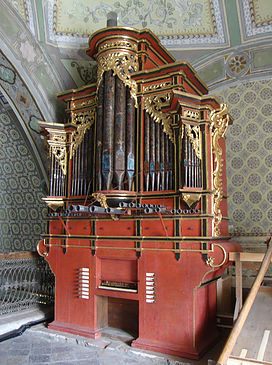
The 1791 Manuel Neri y Carmona organ at Santa María de la Asunción in Tlacolula, Mexico.
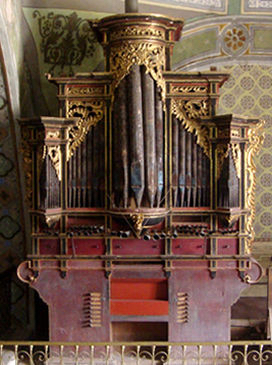
The same, but before restoration.
 The c. 1866 Pedro Nibra de Oaxaca organ at San Matias in Jalatlaco, Mexico. |
 The same, but before restoration. |
 The 1791 Manuel Neri y Carmona organ at Santa María de la Asunción in Tlacolula, Mexico. |
 The same, but before restoration. |
When we work in the communities, the people suddenly become intrigued by the idea of “fixing” their organ, even though many of them are absolute wrecks. The first question is “how much will it cost?” and the second is “who can help pay for it?” So we tell them the truth about the cost and that their community will have to pay much of it, even if they receive outside funding from the FAHHO (which is now no longer an option) or the state or federal government (also dubious). I then ask who will play the organ after the restoration, and they say, “we’ll learn!” Of course you don’t want to dampen such enthusiasm, but also not raise their hopes unrealistically. So then I’ll say “for now, we just want to protect and conserve this wonderful organ, because someday there may be someone in your community with a lot of money who would just love to pay for its restoration. But think about the other needs in your town. Do you have clean water, sewage lines, paved roads, a functioning health clinic, good education and recreation for the children, etc.? For now, those things would be a better investment, and hopefully the organ can be restored sometime in the future.”
People have also written to us from other states of Mexico asking about how to go about restoring their organs. Unfortunately, they do not have an Alfredo Harp Helú (whose foundation has financed such projects in the state of Oaxaca only). Even if there were funding sources available, they need to realize that an intervention in an important historic pipe organ must be directed by a “finished” organbuilder — in other words, a foreigner, since unfortunately there is no Mexican organbuilder fully trained according to international standards who would meet INAH approval. In recent years the INAH has incorporated the organs into the register of the national heritage, in the category of church art, like paintings, statues, and altarpieces. This is an extremely important initiative, but in practical terms it’s not such an easy match since other church objects do not require ongoing use.
Two Oaxacans have been trained by the Grenzing team. One of them worked for years in the shop in Spain and joined up with the organbuilders during the Tlacolula and Jalatlaco restorations. Another is an expert in technical drawings of the organs and presently oversees the maintenance of the two monumental organs in Mexico City Cathedral. Those are the only two I know who are qualified to maintain and repair historic pipe organs.
All that being said, the process really is justified by the product, and every time I hear the sound of the organs which we helped bring back to life, I am deeply moved. Sunday Masses are now played on five restored historic organs: in the Cathedral, Soledad, Tlaxiaco, Tlacolula, and Jalatlaco. Joel and some of our students are regularly contracted to play for weddings, Quince Años, baptisms, etc., because people now want to celebrate these personal events with the pipe organs rather than an electronic keyboard. Another victory!
We consider both the Tlacolula and Jalatlaco restorations to be more successful than we ever could have imagined. Every Sunday in Tlacolula one of our students plays the organ while another has formed a children’s choir which continues to grow and now even includes some adults. The priest was telling us just the other day how the organ has attracted an ever-increasing number of people to the mass, and how it fills the church with sound and creates a completely different atmosphere than the guitar groups or electronic keyboards. This for us means that the Tlacolula restoration is truly finished. I would say the same for the Jalatlaco restoration. This organ has become the center of organ activity in Oaxaca, since it’s located just on the edge of the city in a relatively quiet area, so we use this organ more than the others for concerts and classes. The downtown organs in the Cathedral and the Basìlica de la Soledad, are surrounded by amplified noise — singers and bands with huge speakers, political demonstrations, random musicians, clowns — and it’s increasingly difficult to program organ concerts there.
As you mentioned, the IOHIO also has begun initiatives to teach young Mexican organists. What sort of repertoire do the students learn?
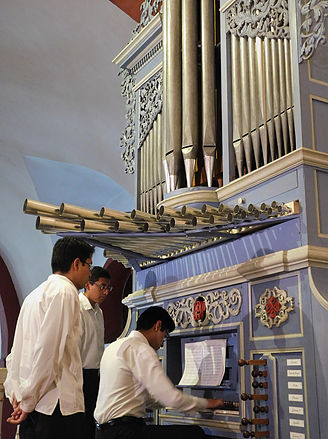
Joel Vásquez and I offer organ lessons nearly every Friday on the Jalatlaco organ because it’s so versatile and conveniently located, but whenever possible on other organs as well (particularly since the Jalatlaco organ is without short octave). There is no university level organ program in Oaxaca, and our students, most of whom couldn’t afford to study outside Oaxaca anyway, have chosen other fields, such as medicine and computer technology. Two are finishing high school, three are in college, and three eke out a living playing masses or teaching music in elementary schools with no plans for further education. Because of their school or work commitments, the number of students in the class may vary. It is ironic that the Mexican organ students invited to participate in our festivals are all studying organ as a career in universities close to their homes, an option unavailable to our own students. In short, Oaxaca has the organs but doesn’t have the organists.

From 2004–2008 the IOHIO had a music academy with the goal of teaching keyboard skills to young people from the villages with organs. It was financed by offering private piano lessons. The students from nearby towns could take their lessons during the week, but those from far away towns could only come in on Saturday mornings — there were around 10 of them. But as soon as they finished high school or even before, they left for the next largest town with better schools. One very talented young girl had to stop taking lessons because her father didn´t believe girls should be educated and that she knew enough about music already. So little by little we lost that group, but our present teaching program continues the impulse of the Academy. Three of our eight students are from Tlacolula and were inspired to study organ after their organ was restored.
We try to make sure our students have a well-rounded repertoire including sixteenth- to eighteenth-century works by Spanish (Cabezón, Cabanilles, Correa de Arauxo, Bruna, Durón…) and other European composers (Froberger, Pachebel, Valenti, Zipoli, Storace, Clerembault…). They study pieces with divided registers, horizontal reeds (clarín), tientos, dances, etc. and learn selections from the Sor María Clara Notebook. We encourage them to listen to and compare interpretations of the pieces they like, to study their structure, and clarify the articulation. We try to include them in concerts at least twice a year. Several of them play the Mass on Sundays or more regularly and we encourage them to play 15 minutes of “real music” afterwards so the congregation can hear the organ in all its glory. Three of them study piano as well and can transfer their Bach preludes and fugues (Well-Tempered Clavier) to the organ, as long as they are in workable keys. There is so much organ repertoire out there that it has never occurred to anyone that they are missing something by the lack of pedals. Of course, everyone would love to play the great organ toccatas and fugues of J. S. Bach, but the Oaxacan organs simply aren’t designed for such music.
How did the recent earthquakes in Oaxaca affect the churches and the organs?
Many churches in the state were damaged, including some of our organ churches, and had to be closed by the INAH for security reasons. For instance, in Tamazulapan we were allowed access to the front half of the church where the organ is located, but not toward the altar because parts of the roof were still unstable and chunks could fall off. Fortunately none of the organs themselves were affected, other than by the jiggling during the quakes which knocked some of the smaller pipes out of tune. Thankfully, the organbuilder Hal Gober had already signed up for the festival and was pressed into service to make the necessary adjustments.
Every two years, IOHIO organizes a week-long festival, the most recent of which took place in February. How many people attended, and what were some of the highlights?
The first festival was in 2001 and they were programmed every year. But because their organization took up so much of our time, we started scheduling them every two years. The goal of the festivals has always been to spread the word about the Oaxacan organs and to provide the opportunity for interested people to see and hear them played by the world’s experts. They now take place in February when the weather is gorgeous in Oaxaca and pretty terrible further north, so they attract many folks dying to escape the cold.
This year’s event was the most extensive and well-attended ever — 9 concerts in 6 days — and we added the recently restored Jalatlaco organ to the roster of concert instruments. Around 100 people signed up, marking continuous growth from previous years, and about a third were returnees. They came mainly from the U.S., Canada, and Mexico, but also from Colombia, the Netherlands, Australia, France, and Spain. We offer a full calendar of activities which are always priced by the day so that participants can design their own packages. The daily fee includes concerts, field trips, meals, and transportation. On most days there were 60–80 participants, although a very popular field trip to the Mixteca Alta drew 90 participants plus staff.
We have worked out a basic structure over the years for the festival activities, although every year we find ways to improve it. As far as the concerts, we invite two international stars to play two concerts each on the most recently restored organs (Cathedral, Tlacolula, Tlacochahuaya, and for the first time Jalatlaco,). This year we were honored by the presence and superb performances of Andrés Cea Galán (Spain) and Jan Willem Jansen (Netherlands). The other five concerts included a group performance by four Mexican students who study organ at the university level and IOHIO organist Joel Vásquez in Tamazulapan; a performance by organist David Soteno and clarinetist Lorenzo Meza in Yanhuitlán (for this concert we always invite a Mexican organist plus another collaborating musician to ensure variety in our programming); two collective concerts in Zautla and Tlaxiaco by professional festival organists; and a program of Oaxacan folk music with percussion in the Basìlica de la Soledad. In addition, we offer visits to unrestored organs, church tours, opportunities for the organists to play a couple of the instruments, typical Oaxacan meals in the villages, amazing scenery during the field trips, and lots of local color. It’s important to remember that the IOHIO festivals attract not only organists, but also professionals, active and retired, of all kinds. What they have in common is a love of music, Oaxacan culture, and an adventurous spirit.
What projects are coming up next for the IOHIO?
Apart from our ongoing work of presenting concerts (averaging one a month), teaching organ, maintaining the organs, and public relations at the local, national, and international level, our next special project is the publication of transcriptions for organ or piano of Oaxacan folk songs and dance music. We recorded this music on a CD and use it as a calling card in the villages so that people can imagine how their organ, which may now be in pieces, might have sounded. The authorities will sometimes broadcast the CD right away on the loudspeaker and are quite excited to make the connection between the sound of the Oaxacan music they know and love and that object sitting in the choir loft of their church. Concerts of this music are the most effective tool we have to entice people to the organs and make them feel invested in them. If they care about them, hopefully they will protect them. Once this music is published (conceived for organ but also aimed at young pianists), we hope it will be widely disseminated.
I have wondered if Oaxacans respond particularly well to the sound of the organ with its flutes and trumpets because it reminds them of their cherished local brass bands. They have a significant role in the communities and play for masses, funerals, and special celebrations in the church. We just heard a funeral mass the other day in Tlacolula and the sound of the band filled the church with slow, heartfelt music as an organ might — it’s a wonderful tradition. I still dream of an antiphonal collaboration between organ and band.
Over the summer we intend to redo our website and brochures and upgrade our technology to include videos. We´d like to make one about “How to recognize a historic organ” that people can access on their cell phones. It would include examples of the cases of table organs that were turned into other furniture — they could be used to store documents or as a decorative piece of furniture in the priest’s bedroom. Or the organ case recycled as an altarpiece and filled with statues of saints and artificial flowers. Or yet another which was converted into a confessional in the 1950s. These days, when we get a report of a piece of furniture that might be an organ, we can ask people to take a picture with their phone and send it to us. The last few leads turned out to be harmoniums (there are hundreds in Oaxaca), and we're always glad that people ask.
After that we can dedicate our time to organizing all the data collected since 2000 for a catalog of the Oaxacan organs in both Spanish and English. This will be our magnum opus and should be published in 2019. After that would be our Festival in February 2020. And we still have lots of material for more CDs, so we’ll work on that once the other projects are finished.
––––––––––––––––––––––––
The views and opinions expressed in this article are those of the author, and do not necessarily reflect the position of Vox Humana.